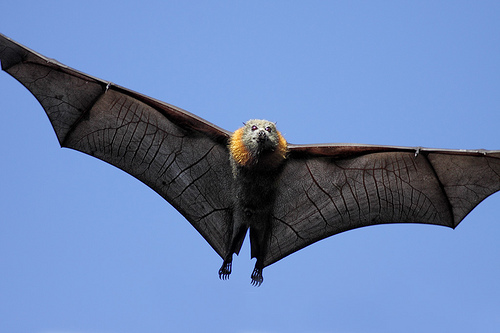Elected representatives in government are in charge of the policy and funding that can make or break saving threatened species. Their decisions and actions matter.
Parkes has or used to have 40 threatened animals within its boundaries. One of them is me, the Grey-headed Flying-fox.
We took care to attach appropriate images that are as close to representative of each species as our resources and the availability of images allowed. However, we could not ensure perfect accuracy in every case. Some images show species that share the same genus but not at the species or subspecies level.
Grey-headed Flying-fox
Pteropus poliocephalus
Status: Vulnerable
The Environment Protection and Biodiversity Conservation Act 1999 (EPBC Act) lists threatened species under six categories:
Extinct, Extinct in the wild, Critically Endangered, Endangered, Vulnerable, Conservation dependent. Read more about these categories
Pteropus poliocephalus is found across 128 electorates.
The Grey-headed Flying-Fox is one of the largest bats in the world with a weight of 600–1000 g and a head-body length of 230–289 mm. It is the only Australian flying-fox that has a collar of orange/brown fully encircling its neck. Thick leg fur extends to the ankle, in contrast to other Pteropus species in which it only reaches the knee. As its name implies, the head is covered by light grey fur. The belly fur is grey, often with flecks of white and ginger. The fur on the back shows two morphs which could be related to age, moult or sub-population. One morph has dark grey fur and the other has a pronounced silver or frosted appearance. Winter fur is darker than summer fur with a pronounced moult occurring in June.¹
Explore more about this species on the Atlas of Living Australia


Explore more about the threats facing species on our Resources page.
- Needle Wattle (Acacia carneorum)
- Curly-bark Wattle (Acacia curranii)
- Androcalva procumbens (Androcalva procumbens)
- Atriplex infrequens (Atriplex infrequens)
- Austrostipa metatoris (Austrostipa metatoris)
- Austrostipa wakoolica (Austrostipa wakoolica)
- Bertya opponens (Bertya opponens)
- Mossgiel Daisy (Brachyscome papillosa)
- Ooline (Cadellia pentastylis)
- Callistemon pungens (Callistemon pungens)
- Moore's Burr-daisy (Calotis moorei)
- Bluegrass (Dichanthium setosum)
- a spike rush (Eleocharis obicis)
- Austral Pipewort (Eriocaulon australasicum)
- Salt Pipewort (Eriocaulon carsonii)
- Frankenia plicata (Frankenia plicata)
- Flame Spider-flower (Grevillea kennedyana)
- Lake Keepit Hakea (Hakea pulvinifera)
- Belson's Panic (Homopholis belsonii)
- Homoranthus darwinioides (Homoranthus darwinioides)
- Indigofera efoliata (Indigofera efoliata)
- Spiny Pepper-cress (Lepidium aschersonii)
- Winged Pepper-cress (Lepidium monoplocoides)
- Chariot Wheels (Maireana cheelii)
- a green alga (Nitella parooensis)
- Hawkweed (Picris evae)
- a leek-orchid (Prasophyllum sp. Wybong )
- Sclerolaena walkeri (Sclerolaena walkeri)
- Menindee Nightshade (Solanum karsense)
- Slender Darling-pea (Swainsona murrayana)
- Red Darling-pea (Swainsona plagiotropis)
- Yellow Swainson-pea (Swainsona pyrophila)
- Small Purple-pea (Swainsona recta)
- Austral Toadflax (Thesium australe)
- Tylophora linearis (Tylophora linearis)
- Xerothamnella parvifolia (Xerothamnella parvifolia)
- Ingram's Zieria (Zieria ingramii)
You are in federal electorate Parkes.
